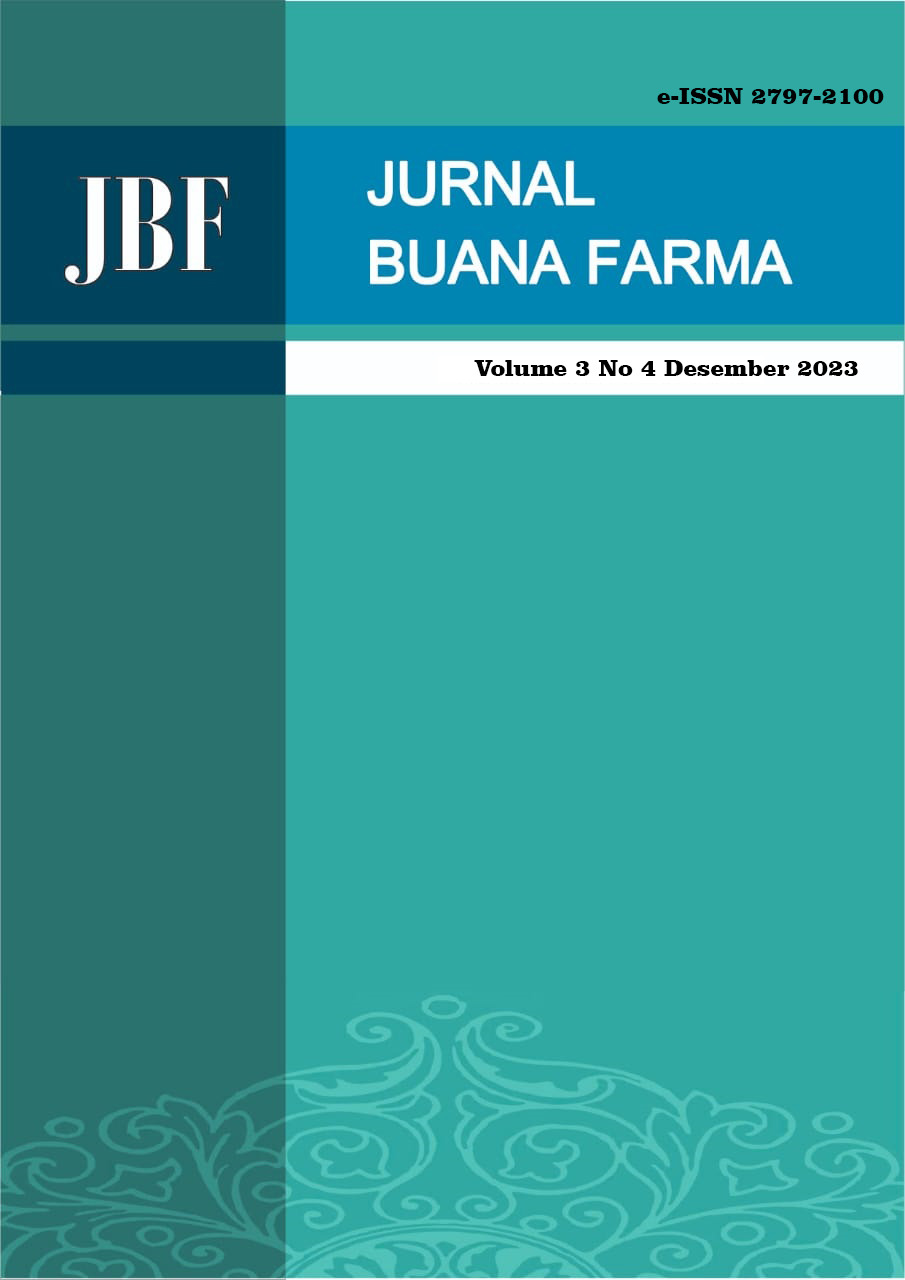FORMULASI SEDIAAN SHAMPO EKSTRAK ETANOL DAUN KOPI ARABIKA (Coffea arabica L.) DAN EVALUASI FISIKNYA
Abstract
A hair problem that can interfere with the appearance and beauty of hair is dandruff. One way to treat dandruff is to use anti-dandruff shampoo. Arabica coffee leaves (Coffea arabica L.) contain various chemical compounds so they have the potential to be used as active substances in shampoo preparations. The aim of this research is to develop a shampoo preparation formula for ethanol extract of Arabica coffee leaves and look at its physical evaluation. Each shampoo contains 0% (F0), 15% (F1), 20% (F2), 30% (F3), 45% (F4), 60% (F5) ethanol extract of Arabica coffee leaves and a physical evaluation is carried out. including organoleptic tests, homogeneity tests, pH tests, foam height tests, stability tests, pH tests, stability tests and viscosity tests. The organoleptic test results showed that F0 was colorless, F1-F5 were blackish green, all formulas were in the form of a thick mass and had the aroma of coffee. The examination results showed that all formulas were homogeneous; pH ranges from 5.0 to 9.0; foam height ranges from 1.62 to 3.97 cm; the preparation does not separate (stable); viscosity ranges from 1247-3011 cp. From various physical evaluation results, it can be concluded that Arabica coffee leaf ethanol extract shampoo can be made into a shampoo that meets the requirements.
References
Ambarwati, Sujono, T. A., & Sintowati, R. (2016). Uji Aktivitas Ekstrak Daun Pandan Wangi (Pandanus amaryllifolius Roxb.) sebagai Antibakteri. University Research Colloquium.
Dhanavade, Dr. M. J., Jalkute, Dr. C. B., Ghosh .J., Sonawane K. D. (2011). Study antimicrobial activity of lemon (Citrus lemon L) peel extract. British Jurnal of Pharmacology and Toxicology. 2(3):119-122.
Fauziah,D,W, Yamaesa G.K. (2019). Formulasi Sampo Ekstrak Daun Mangga (Mangifera indica L.). Jurnal Ilmiah Farmasi Vol. 6 No. 1 ISSN P,2406-8071 E.2615-8566.
Hakim, N. A., Arianto, A., & Bangun, H. (2018). Formulasi dan Evaluasi Nanoemulsi dari Extra Virgin Olive Oil (Minyak Zaitun Ekstra Murni) sebagai Anti-Aging. Talenta Conference Series: Tropical Medicine (TM), 1 (2): 391–397.
Lestari D. A., Juliantoni Y., & Hasina R. 2020. Optimasi Formula Sampo Ekstrak Daun Pacar Air (Impatiens balsamina L.) dengan Kombinasi Natrium Lauril Sulfat dan Cocamide DEA. Sasambo Journal of Pharmacy, Volume 2, Nomor 1: 23-31.
Malonda M., Paulina, Gayatri. (2017). Formulasi Sediaan Sampo Antikombe Ekstrak Daun Pacar Air (Impatiens balsamina L.) Dan Uji Aktivitasnya Terhadap Jamur Candida albicans ATCC 10231 Secara In Vitro. Jurnal Ilmiah Farmasi-UNSRAT. Vol. 6 No.4.
Mardatila, A. (2022). Uji Aktifitas Antibakteri Ekstrak Etanol Kulit Buah Markisa Konyal (Passiflora ligularis Juss) Terhadap Staphylococcus epidermidis dan Escherichia coli. Skripsi S1 Farmasi. Padang: UPERTIS
Nurhikma E., Dewi A., Selfyana A. (2018). Formulasi Sampo Anti Ketombe Dari Ekstrak Kubis (Brassica oleracea Var. Capitata. L.) Kombinasi Ekstrak Daun Pandan Wangi (Pandanus amaryllifolius Roxb).Jurnal Mandala Pharmacon Indonesia. Vol 4 No 1.
Pamudji, J. S .,Wibowo, M. S., Angelia. (2014). Formulasi sampo antiketombe yang mengandung tea tree oil dan pengujian aktivitas sediaan terhadap Malassezia furfur. Acta Pharmaceutica Indonesia. Vol. XXXIX, No. 1&2.
Siagian, A. S., Widjaja, H. (2022). Pengaruh Perbedaan Konsentrasi Climbazole Sediaan Sampo Antiketombe Terhadap Aktifitas Antijamur Candida albicans. Jurnal Ilmiah Farmasi Vol 11 No.1 Tahun 2022.
Permadi, Y. W. & Mugiyanto E. (2018). Formulasi Dan Evaluasi Sifat Fisik Shampo Anti Ketombe Ekstrak Daun Teh Hijau. Jurnal Farmasi Sains dan Praktis, Vol. IV, No. 2: 62-66.
Potluri. (2013). Formulation and Evaluation of Herbal Anti-Dandruff Shampoo. Indian Journal of Research in Pharmacy and Biotechnology. 1(6): 835-839.
Pristiana, D.Y., Susanti, S. & Nurwantoro, (2017). Antioksidan dan Kadar Fenol Berbagai Ekstrak Daun Kopi (Coffea sp.): Potensi Aplikasi Bahan Alami untuk Fortifikasi Pangan. Jurnal Aplikasi Teknologi Pangan. 6 (2), 89–92. doi:10.17728/jatp.205.
Rasyadi, Y., Yenti, R., & Jasril, A. P. (2019). Formulasi dan uji stabilitas fisik sabun mandi cair ekstrak etanol buah kapulaga (Amomum compactum Sol. Ex Maton). PHARMACY: Jurnal Farmasi Indonesia (Pharmaceutical Journal of Indonesia), 16(2), 188-198.
Rasyadi, Y. (2022). Formulasi dan uji stabilitas handbody lotion ekstrak etanol daun sirsak (Annona muricata Linn.). Parapemikir: Jurnal Ilmiah Farmasi, 11(1), 15-23.
Rasyadi, Y., Sartika, D., & Fitri, N. D. (2023a). Carbopol Sebagai Gelling Agent Yang Baik Pada Formulasi Sediaan Gel Facial Wash Ekstrak Etanol Daun Kopi Arabika (Coffea arabica L.). Jurnal Insan Farmasi Indonesia, 6(1), 144-156.
Rasyadi, Y. (2023b). Formulasi Dan Karakterisasi Body Butter Ekstrak Etanol Daun Kopi Arabika (Coffea arabica L) Dengan Cocoa, Shea, Dan Coconut Butter. Parapemikir: Jurnal Ilmiah Farmasi, 12(2), 178-184.
Schmitt W. H. (1996). Skin Care Product. Di dalam Williams DF and Schmitt WH, editor. Chemistry and Technology of The Cosmetics and Toiletries Industry. 2nd Ed. London: Blackie Academe and Profesional.
Silvia, Arreneuz S., & Wibowo M. A. (2015). Aktivitas Antimikroba Ekstrak Daun Soma (Ploiarium alternifolium Melch) Terhadap Jamur Malassezia furfur dan Bakteri Staphylococcus aureus. JKK, Vol 4(3): 84-93.
SNI. (1992). Shampo,06-2692-1992. Jakarta: Standar Nasional Indonesia.













